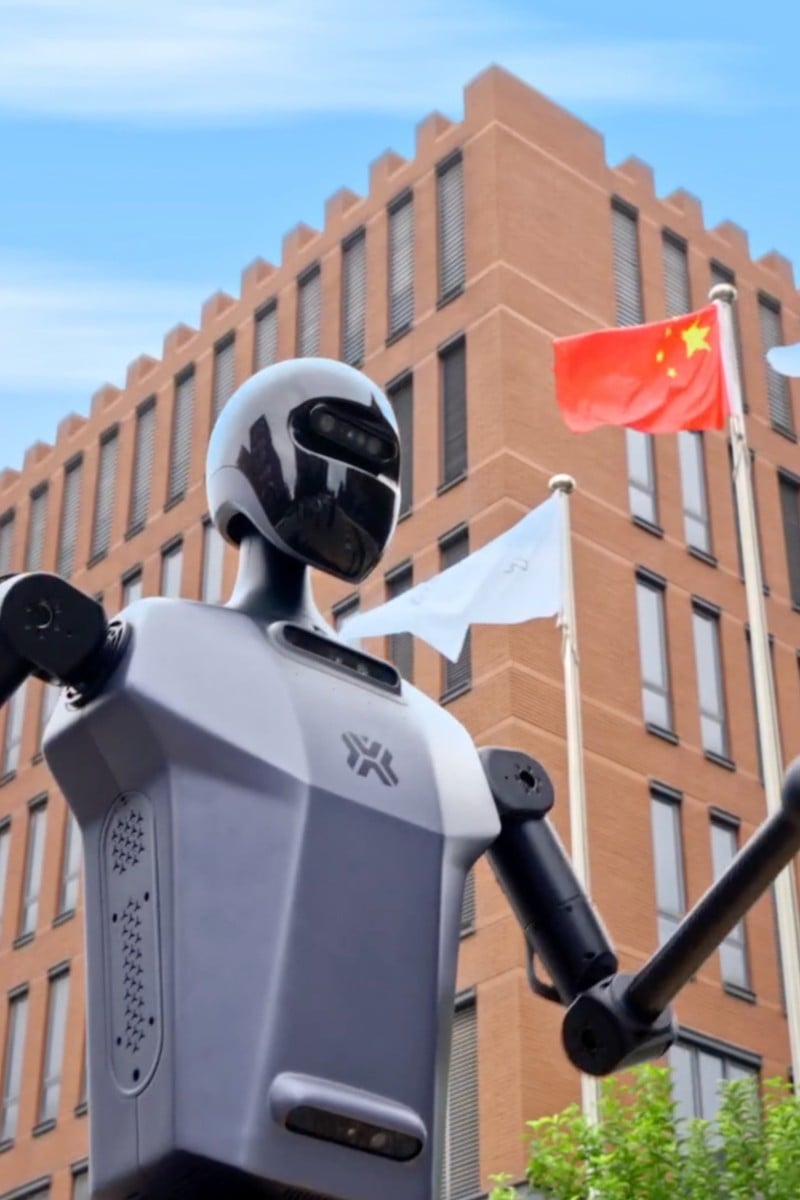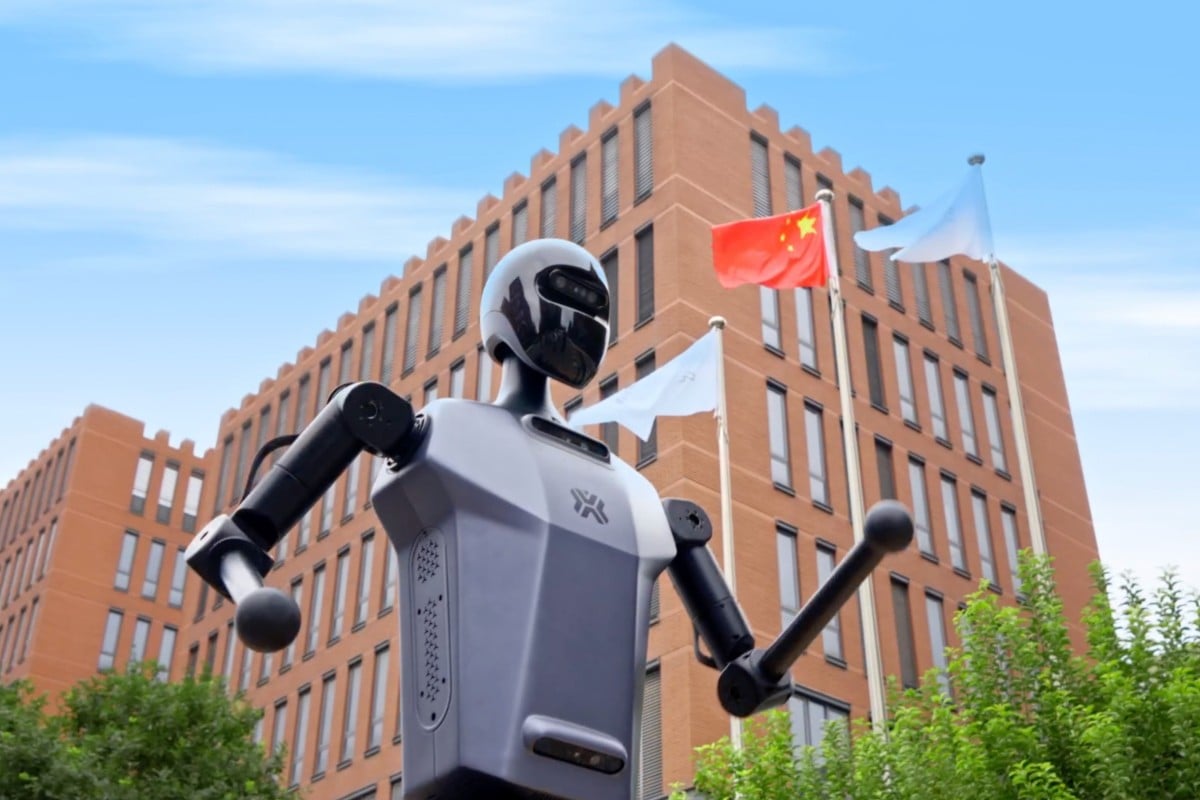
Deep Dive: In the new ‘space race’, US and China compete to produce humanoid robots
The US may have to change its strategy thanks to Chinese firm DeepSeek’s AI, which looks promising for the future of the machines
 The US and China are competing for dominance in the field of humanoid robotics. Photo: Handout
The US and China are competing for dominance in the field of humanoid robotics. Photo: HandoutDeep Dive delves into hot issues in Hong Kong and mainland China. Our easy-to-read articles provide context to grasp what’s happening, while our questions help you craft informed responses. Check sample answers at the end of the page.
News: US and China battle to become leaders in humanoid robotics
-
Release of DeepSeek’s large language model could force the US to change its approach to technology
-
Chinese companies are competing against each other to capture market share
Players from all over the world are eager to take the lead in humanoid robotics. No one country is completely dominant in this 21st century “space race”. However, China and the United States are undoubtedly in the first tier.
“In the US, the focus is on staying at the forefront of technology and exploring unknown technical challenges,” said Xu Xuecheng. He is a lead scientist with the Zhejiang Humanoid Robot Innovation Centre.
Meanwhile, Chinese companies are invested in building humanoid robots for real-world use. “The focus is more on how to integrate existing technologies for practical application,” Xu said.
However, the release of DeepSeek’s R1 large language model (LLM) earlier this year could change the US’ strategy. The Chinese AI start-up stunned the world with its LLM. Not only does it match the quality of the one produced by US company OpenAI, but it was also developed for less money.
Each humanoid robot has a highly advanced “brain” powered by AI, machine learning, and sensors. The brain helps it perceive its environment and act.
Deep Dive: Chinese AI firm DeepSeek challenges ChatGPT with new chatbot
Meanwhile, a sophisticated “body” built from lightweight materials uses flexible joints for lifelike motion. The brain and body work together to enable the robots to mimic human behaviour.
Many companies have said they will begin mass production of their models in 2025. China – long known as the “world’s factory” – has extended its manufacturing dominance to the world of robotics.
According to the International Federation of Robotics, more than half of global robot installations took place in China in 2023. This gives Chinese companies an advantage in cost control as they enter the home market.
“If companies can’t keep their prices under 200,000 yuan (HK$212,664) this year, it will be very difficult to push their products,” said He Liang, a professor at Northwestern Polytechnical University in Xian. He added that companies are not making much profit right now. Instead, they are focused on quickly capturing market share.
“To some extent, we’re already seeing a price war [in China],” He said.
Robotics firm Unitree recently revealed its production plans. Its basic G1 model will cost 99,000 yuan (HK$105,269). This is much less expensive than the typical 500,000 yuan (HK$531,661) its competitors charge.
Company founder Wang Xingxing has said costs will drop even further as production increases.
Staff writers
Question prompts
1. Based on the information in News, which of the following are true?
(1) Advancements in AI technology can help develop new versions of humanoid robots more quickly.
(2) According to He Liang, companies need to price their humanoid robots at under 200,000 yuan so people will buy them.
(3) Less than half of global robot installations took place in China in 2023.
(4) Unitree is pricing its basic model at 150,000 yuan.
A. (1), (2) only
B. (1), (3) only
C. (2), (3) only
D. (2), (4) only
2. According to News, what advantages does China have in producing the newest humanoid robot models?
3. Why does professor He Liang say China is undergoing a “price war”, and how does he think price will dictate the production of humanoid robots in the future?
Graph
Question prompts
1. List TWO trends being shown in the graph.
2. How does this graph correlate with the information presented in News?
Issue: Could humanoid robots become elderly carers in China?
-
Most humanoid robots are used in an industrial setting, but demand for domestic devices is increasing
-
Some have cited the elderly care sector as one with “endless potential” for the machines
Humanoid robots made by Hangzhou-based Unitree captivated audiences with a dance at China’s Spring Festival Gala, the world’s most-watched annual TV programme, during Lunar New Year.
After the performance, the internet was flooded with enthusiastic netizens envisioning a future of robotic assistance: “I need a robot for elder care,” one wrote, while others dreamed of robots capable of washing hair, cooking and cleaning.
“Looking forward to an all-in-one eldercare robot,” a user commented, while another said, “Forget having kids – save millions and buy a robot for retirement, instead.”
The response highlights a growing demand for domestic humanoid robots in China.
Humanoid robots made their first major strides on car factory floors, with both Chinese and international humanoid robotics companies initially focusing on their use in the automotive industry.
Most humanoid robots deployed in real-world applications have been used in industrial environments, such as logistics and manufacturing. The rest are mainly used in research and educational institutions.
But, for the average person, humanoid robots do not yet deliver concrete, hands-on support in everyday tasks.
Deep Dive: Hong Kong hopes foreign nurses can fight shortage
While experts agree that we are entering the age of humanoid robots, they said the market will only truly open once they expand into consumer-facing applications.
This year is widely predicted to be a key moment for the mass production of humanoid robots and the industry’s global commercialisation.
A Goldman Sachs report published last year said the total market for humanoid robots is projected to reach US$38 billion (HK$295.2 billion) by 2035, a more than sixfold increase on its previous projection of US$6 billion (HK$46.6 billion).
Wang Xingxing, founder of Chinese company Unitree Robotics, has cited the elderly care sector as “a field with boundless potential”.
There were 216.76 million people aged 65 and older in China by the end of 2023, accounting for 15.4 per cent of the country’s population.
“In the future, if an elderly care robot is priced at around 50,000 yuan (HK$53,154), and one in every 30 of the 300 million elderly people buys one, the market could reach a staggering 500 billion yuan (HK$531.5 billion),” said Wang.
A carer for the elderly can earn more than 10,000 yuan (HK$10,630) a month in big Chinese cities like Beijing or Shanghai. As demand increases in the rapidly ageing society, families will have an incentive to buy robotic replacements once the technology is mature enough, Wang said.
However, he also acknowledged that current technology remains short of producing a fully functional elderly care robot.
Staff writers
Question prompts
1. Based on the information in Issue, which of the following are true?
(1) Humanoid robots created by Unitree performed a dance on TV for the Mid-Autumn Festival.
(2) In cities like Shanghai, carers for the elderly can earn more than HK$10,000 per month.
(3) The market for humanoid robots will likely reach US$38 billion in the next 10 years.
(4) By the end of 2023, China’s senior population accounted for 19 per cent of the country’s total population.
A. (1), (2) only
B. (1), (4) only
C. (2), (3) only
D. (3), (4) only
2. According to Issue, why might there be a need for humanoid robot carers for the elderly, and why could they appeal to families?
3. Using the information in News and Issue, list TWO ways humanoid robots are currently used in China. Are they ready to be used as carers? Why or why not?
Cartoon
Question prompts
1. What does this cartoon depict, and how does it relate to the information presented in News and Issue?
2. What is ONE way humanoid robots could be used in Hong Kong? Explain your answer using Issue and your own knowledge.
Glossary
humanoid robotics: building robots that resemble the human body in shape. The design may be for functional purposes, such as interacting with human tools and environments, or for experiments.
space race: a period of competition between the Soviet Union and the United States over who could conquer space exploration first. During the Cold War in the mid-20th century, the two countries competed against each other for international dominance, and the space race was a symbol of the tense relationship between the superpowers.
large language model: artificial intelligence systems capable of understanding and generating human language by processing vast amounts of text data
logistics: the overall process of managing how resources are acquired, stored, and transported to their final destination
Goldman Sachs: a global investment banking firm headquartered in New York City that provides a huge range of financial services to institutions, corporations, governments and people worldwide.
Sample answers
News
1. A
2. China is now a forerunner in AI technology, particularly with the groundbreaking debut of DeepSeek. With AI technology, China can develop new models of humanoid robots with more intelligent capabilities.
In addition, China is the “world’s factory”, meaning they can manufacture a large amount of products – and quickly. There is more bandwidth, money, resources, and infrastructure already in place for many companies to create a horde of robots.
3. Companies making humanoid robots are competing for customers and trying to price their products lower than those of their competitors. Humanoid robots may soon take off in China, and companies want to become the top seller right away.
He says companies must price their units below 200,000 yuan so that customers will be willing to buy their products. Unitree is one of the leaders regarding price, with its simple model costing 99,000 yuan, while other competitors have priced their models at 500,000 yuan.
Ultimately, consumers will choose the options that are the most affordable. An increase in supply will likely drive the price down as well.
Graph
1. The graph shows that the amount of money to be made in China’s humanoid robot market is estimated to increase significantly by 2026. Although there was a slight dip in 2022, estimated revenue in 2026 will be 10 times more than the amount made in 2021.
2. This information relates to News because it shows the sales figures for humanoid robots, both in the past and estimated projections, and backs up the idea that robots are becoming more popular in China as more companies enter the marketplace.
Issue
1. C
2. China has an ageing population, as Wang pointed out. More and more elderly people will need to be cared for, and there aren’t enough younger people to support them. Therefore, it makes sense to create robots to close this gap.
Additionally, as carers are paid around 10,000 yuan per month in some cities, buying a robot for around 50,000 yuan means it would pay for itself in five months. This would lessen the burden for families who would otherwise need to consistently pay someone each month for care.
3. Currently, humanoid robots are deployed in industrial environments such as the automotive industry, mainly manufacturing and logistics. They also serve in research and education.
Robots have not advanced enough to be used for elderly care, and the technology is not mature enough. However, this could change with developments in AI technology, which can hone the robots’ potential and allow them to evolve more quickly.
Cartoon
1. This cartoon shows a robot walking from one cliff to another with the help of a hand. On the sleeve of the hand is a Chinese flag. This relates to News and Issue because it symbolises how China is helping to develop humanoid robots.
2. Once humanoid robots become advanced enough to act as carers, domestic helper robots could become the norm in Hong Kong. This would certainly lessen the load for people who need to care for their parents and children, but don’t have the space or money for a domestic helper. Getting a robot in the long run would ultimately be less expensive. However, this comes at the cost of the foreign domestic helpers who come to Hong Kong to work. It is also unlikely that a robot could provide the same level of personalised care and human connection.
